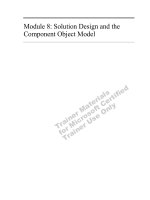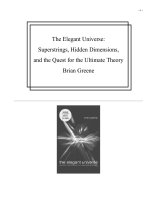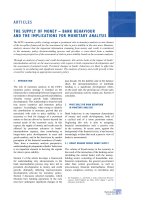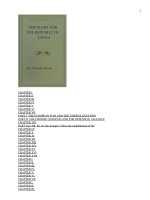4 8 jose marti and the fight for cuban independence
Bạn đang xem bản rút gọn của tài liệu. Xem và tải ngay bản đầy đủ của tài liệu tại đây (3.6 MB, 10 trang )
Fascinating Facts
• José Martí’s father was Spanish and his mother was
from the Canary Islands.
• Though famous as a freedom fighter, José Martí
was a small, thin man. Because of an injury he got
when he was imprisoned, he walked with a cane
for most of his life.
• José Martí lived in New York for a time. While he
was there, he started a magazine for children called
Edad de Oro, which means “golden age.”
Genre
Nonfiction
Comprehension Skill
Sequence
Text Features
•
•
•
•
Captions
Time Line
Map
Sidebars
Scott Foresman Social Studies
AND THE FIGHT FOR CUBAN INDEPENDENCE
by Ann Rossi
José Martí was one of the most famous Cuban writers
of the 1800s. He was also a Cuban patriot who wanted
his country to be free. He faced prison and even death
because of this. You will read about Martí’s life and how
he used his writing to help others learn of Cuba’s fight
for independence.
Vocabulary
tourist
revolutionary
patriot
immigrant
exile
amnesty
liberty
Write to It!
José Martí wanted to make changes when he
saw things that he did not think were right.
He often wrote newspaper articles to try to
bring about change. Think of something
in your community that you would like to
see change. Write a two- or three-paragraph
newspaper article describing what you would
like to see changed, why it should change, and
how you would change it.
Write your article on a separate sheet of paper.
AND THE FIGHT FOR CUBAN INDEPENDENCE
by Ann Rossi
Photographs
Every effort has been made to secure permission and provide appropriate credit for photographic material. The publisher
deeply regrets any omission and pledges to correct errors called to its attention in subsequent editions.
Unless otherwise acknowledged,
all Offices:
photographs
are the property
Foresman,New
a division
of Pearson
Editorial
Glenview,
Illinoisof•Scott
Parsippany,
Jersey
• NewEducation.
York, New York
Photo locators denoted as follows: Top (T), Center (C), Bottom (B), Left (L), Right (R) Background (Bkgd)
Sales Offices: Needham, Massachusetts • Duluth, Georgia • Glenview, Illinois
ISBN: 0-328-14671-4
Copyright © Pearson Education, Inc. All Rights Reserved. Printed in the
United States of America. This publication or parts thereof, may be used with appropriate
equipment to reproduce copies for classroom use only.
1 2 3 4 5 6 7 8 9 10 V0G1 14 13 12 11 10 09 08 07 06 05
Opener: ©Brown brothers
Coppell, Texas • Ontario, California • Mesa, Arizona
2 ©Scott Smith/Index Stock Imagery
5 ©Maps.com/Index Stock Imagery
7 ©Photo restoration by J.A.Sierra/Timetable History of Cuba/Jerry Sierra
8 ©Corbis
11 ©SuperStock
15 (T) ©Audrius Tomonis, (B) ©Jeffrey Boan/Miami Herald Publishing Company
Monument to a Cuban Patriot
Each year, millions of people travel to the Miami area
to enjoy its warm weather, fine beaches, cultural sites,
and wide variety of fun things to do. These tourists
may spend their time admiring the downtown skyline’s
glass-walled skyscrapers, or they may choose to explore
one of Miami’s neighborhoods, such as Little Havana.
Both those who visit and those who live in Little
Havana can walk along Memorial Boulevard and
study the monuments to learn about the history and
culture of Cuba. While exploring the neighborhood,
they might stop to look at the memorial honoring
the Cuban writer and revolutionary José Martí. Some
visitors may wonder who José Martí is.
Martí dedicated his life to fighting for Cuban
independence from Spain. Martí’s desire to free his
country from foreign rule can be easily
understood by Americans, whose own
revolutionary patriots fought to free the
United States from British rule. Martí is
often thought to be the symbol of Cuba’s
struggle for independence from Spain.
Little Havana
The Little Havana district in Miami, Florida, gets its name
from Havana, Cuba, because of the thousands of Cubans
who settled in this part of Miami beginning in the late
1950s. Many of these Cuban immigrants opened
shops and restaurants that carry goods that remind them
of their homeland. Restaurants serve special meats, fish,
black beans and rice, plantains, and other traditional
Cuban foods. In Maximo Gomez Park, neighborhood
people gather to play dominoes and chess, two games
that are very popular in Cuba.
This is the José Martí Memorial
in Miami, Florida.
2
3
Martí’s Early Years
On January 28, 1853, José Julián Martí y Pérez
was born in Havana, Cuba. He was the eldest child of
Mariano Martí and Leonor Pérez. His parents also
raised five daughters.
Though his family was poor, Martí received an
excellent education. Martí’s mother was a firm believer
in the importance of education. One of Martí’s teachers
was a poet. He took a special interest in young Martí’s
education. Because of his teacher’s encouragement,
Martí had published several of his own poems by the
age of fifteen.
Spanish Rule of Cuba
In 1492 Christopher Columbus sailed from Spain in
hopes of finding a westward sea route to Asia. While
exploring, he landed in Cuba. Nearly twenty years later,
in 1511, Spanish soldiers and settlers took control of
Cuba, and Cuba became a Spanish colony.
During Martí’s lifetime, almost four hundred years later,
Cuba was still ruled by Spain. Attempts by Cubans to
gain independence failed. Not until 1898 was Cuba
freed from Spain, after Spain was defeated by the United
States in the Spanish-American War.
4
The Ten Years’ War, Cuba’s first struggle for
independence from Spain, began in 1868. Like other
Cubans fighting for independence, Martí thought
Cuba should rule itself. In 1869, at the age of sixteen,
Martí started a newspaper dedicated to Cuba’s
independence. With the publication of La patria libre
(The Free Fatherland ), Martí began his lifelong fight
for Cuban liberty.
Martí’s sympathy with and support of those fighting
for Cuban independence brought him into conflict
with the Spanish government. He was arrested and
sentenced to six years of hard labor. Later, in 1871, he
was exiled to Spain, where he would live for several
years, forbidden to return to Cuba.
Cuba, the largest island in the West Indies, is located about 90 miles
(145 kilometers) south of Key West, Florida.
5
Twice an Exile
The Writings of José Martí
Martí did not let his absence or his distance from
Cuba stop him from fighting for his homeland’s
independence. Martí wrote numerous political essays.
He also wrote a harsh criticism of Cuban prisons,
exposing the horrible treatment of political prisoners.
This attack was published as a pamphlet.
Martí shared his mother’s belief in the importance of
a good education. Although he was far from home, he
continued to learn and study in Spain. After attending
classes at both the University of Madrid and the
University of Zaragoza, Martí graduated in 1874 from
the University of Zaragoza. He received two degrees,
one in philosophy and the other in law.
After graduating Martí set out on a series of travels,
first in France, then in Mexico and Guatemala. In
Guatemala, Martí took a job as a professor, teaching
history and literature. While there he married Carmen
Zayas Bazán, the daughter of another exiled Cuban.
Cuba’s Ten Years’ War ended in 1878, with the signing
of the Pact of Zanjon. This treaty called for a number of
political reforms, or changes, to take place in Cuba.
José Martí wrote a lot of poetry. Many of his poems
were published during his lifetime, including the
collections Ismaelillo, published in 1882, and Versos
sencillos (Simple Verses) published in 1891. Some of his
poetry was published after his death, including a
collection of the poems he wrote between 1878 and
1882. These poems were published in 1913 as Versos
libres (Free Verses). In keeping with the title, the poems in
this collection have the theme of freedom.
Martí wrote many political
essays as well, which have
been gathered together. Some
of Martí’s essays reveal his
admiration for the United
States and its political figures,
including the writers of the
United States Constitution.
Martí had firsthand experience of
the horrors of Cuban prisons.
6
7
At the end of the Ten Years’ War, exiled Cubans
were given amnesty, a pardon for offenses against the
government, and were allowed to return to Cuba.
Within the year Martí and his wife were back on
Cuban soil. Martí, however, would not remain in Cuba
for long.
Although the Ten Years’ War was over, Spain still
governed Cuba. Back in his homeland, Martí continued
to push for Cuban independence. As a result, he was
exiled once again in 1879. Martí was put in a Spanish
prison, although he remained there only a short time
because he escaped. From Spain he again went to
France and then to New York City.
In 1881 Martí moved to Venezuela, hoping to make
a home for himself. He began his new life by founding
the Revista Venezolana (Venezuelan Review), but the
political viewpoints expressed in this newspaper angered
the dictator of Venezuela. Martí was forced to leave
Venezuela, and he returned to the United States.
José Julián Martí y Pérez
8
9
Living in New York
From 1881 to 1895 Martí spent most of his time in
New York City. He traveled occasionally, and he continued
to write. In addition to poems and political essays, Martí
wrote newspaper articles and a magazine for children.
Martí wrote about his love of liberty, or freedom. He
wrote about justice and education. Many of his essays
helped countries to better understand one another.
While in New York, Martí worked as a journalist for
several Latin American newspapers, including La nación
(The Nation), a newspaper from Buenos Aires, Argentina.
Martí wrote about life and important events in the United
States. One major event he wrote about was the dedication
of the Statue of Liberty on October 28, 1886. The Statue
of Liberty was a gift from the people of France to the
people of the United States.
Martí vividly described the sights and sounds of
the celebration, including the parades, the crowds, the
speeches, and the statue itself. He explained how France
had played an important part in the War of Independence
when the Thirteen Colonies fought Great Britain and
became the United States. The statue reminded Martí of
the liberty he hoped to bring to his own people.
10
Martí’s articles made him famous throughout Latin
America. His writing helped others understand the
importance of liberty.
While he was in the United States, Martí spent much
of his time planning how to achieve independence
for Cuba. He traveled to Florida and other places,
gathering support among exiled Cubans. His writing
and speeches inspired Cubans from many backgrounds
to unite in the effort
to achieve Cuban
independence.
In 1892 Martí
helped form the Cuban
Revolutionary Party. In
the years that followed,
Martí collected supplies
and planned an invasion of
Cuba to free his homeland
from Spanish rule.
Liberty Enlightening the World,
popularly called the Statue of Liberty,
was dedicated in New York on
October 28, 1886.
11
A Last Return
A few years later, in 1898, the United States declared
war on Spain after an American battleship exploded and
sank in Havana harbor. The battleship had been sent
to Havana to protect American citizens in Cuba. The
United States blamed Spain for the explosion. Spain
surrendered shortly after the United States declared war
and agreed to give up its right to rule Cuba. At last,
Cuba had achieved independence.
In early 1895 Martí left New York and went on his
last journey to Cuba. Now, he felt, the time was right
to fight for Cuba’s independence. Cubans from many
backgrounds were ready to fight with him.
By early April 1895 Martí and the patriots who
accompanied him had arrived in Cuba. Just over one
month later, on May 19, Martí was killed in battle. José
Martí had spent his entire life telling people about the
benefits of freedom for Cuba. Although he did not live to
see a free Cuba, Martí continued to inspire others to fight
for Cuba’s independence.
1874
Martí graduates from university.
The Life and Times of José Martí
1878
The Ten Years’ War ends. The
Pact of Zanjon allows political
exiles to return to Cuba. Martí
and his wife arrive in Cuba.
1871
Martí is exiled
to Spain.
1853
José Martí
is born in
Havana, Cuba,
on January 28.
1850
1868
1881
The Ten Years’
War begins.
1855
1860
1865
Martí moves to Venezuela and then
settles in the United States.
1870
1869
Martí publishes his first
newspaper, La patria libre.
12
1895
Martí leaves New York.
A new war for Cuban
independence begins.
May 19:
Martí is killed in battle.
1875
1880
1885
1890
1895
1892
1879
Martí helps form
the Cuban
Revolutionary
Party.
Martí is exiled again.
13
Remembering Martí
Many people today continue to remember and
honor Martí. They consider him a patriot who loved
his country so much that he was willing to fight—and
die—for its liberty. People remember Martí when
they read his writings, which continue to educate and
inspire.
Martí’s memory has been honored in many ways.
Statues have been erected in cities such as Havana,
Cuba, and Miami, Florida. Schools, an airport, and a
park are named after him.
Students and teachers also honor Martí. In late
January the José Martí Parade takes place in the Miami
area to celebrate his birth. Students and teachers
participate in the parade by singing songs, reciting
poems, and decorating floats. Although Martí died
more than a hundred years ago, his dedication to
independence continues to inspire others.
14
The image of José Martí is found on Cuban money.
Students from the
Miami area represent
their schools in the
José Martí Parade.
15
José Martí was one of the most famous Cuban writers
of the 1800s. He was also a Cuban patriot who wanted
his country to be free. He faced prison and even death
because of this. You will read about Martí’s life and how
he used his writing to help others learn of Cuba’s fight
for independence.
Glossary
amnesty a pardon for offenses against a government
exile being forced to live away from one’s country
immigrant a personVocabulary
who leaves one country
to live in another
tourist
liberty freedom from the control of another country;
revolutionary
independence
patriot
patriot a person who immigrant
loves and supports his or
her country
exile
revolutionary a personamnesty
who is trying to bring about
liberty
a major change in government
tourist a person who travels for enjoyment
Write to It!
José Martí wanted to make changes when he
saw things that he did not think were right.
He often wrote newspaper articles to try to
bring about change. Think of something
in your community that you would like to
see change. Write a two- or three-paragraph
newspaper article describing what you would
like to see changed, why it should change, and
how you would change it.
Write your article on a separate sheet of paper.
Photographs
Every effort has been made to secure permission and provide appropriate credit for photographic material. The publisher
deeply regrets any omission and pledges to correct errors called to its attention in subsequent editions.
Unless otherwise acknowledged, all photographs are the property of Scott Foresman, a division of Pearson Education.
Photo locators denoted as follows: Top (T), Center (C), Bottom (B), Left (L), Right (R) Background (Bkgd)
ISBN: 0-328-14671-4
Copyright © Pearson Education, Inc. All Rights Reserved. Printed in the
United States of America. This publication or parts thereof, may be used with appropriate
equipment to reproduce copies for classroom use only.
1 2 3 4 5 6 7 8 9 10 V0G1 14 13 12 11 10 09 08 07 06 05
16
Opener: ©Brown brothers
2 ©Scott Smith/Index Stock Imagery
5 ©Maps.com/Index Stock Imagery
7 ©Photo restoration by J.A.Sierra/Timetable History of Cuba/Jerry Sierra
8 ©Corbis
11 ©SuperStock
15 (T) ©Audrius Tomonis, (B) ©Jeffrey Boan/Miami Herald Publishing Company









